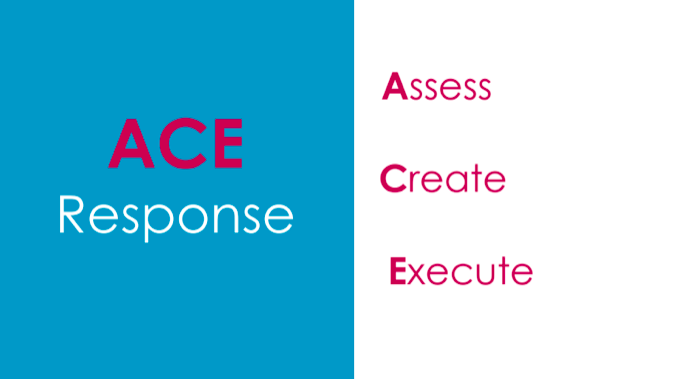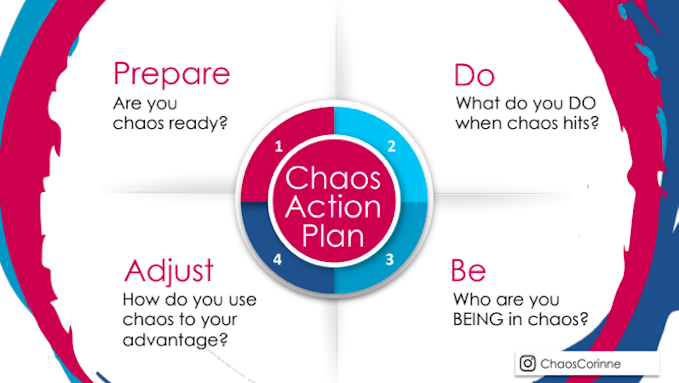Chaos Advantage: Navigating High-Stress Situations
by Sirley Carballo · Jul 18, 2023

Corinne Hancock presenting at the 2023 Engage Summit
Gaining the Chaos Advantage
At the 2023 Engage Summit, Corinne Hancock, a renowned speaker, cultural anthropologist, and certified chaos coach, delivered a powerful and thought-provoking keynote session for higher education professionals.
With a focus on embracing chaos and utilizing it as an advantage, Hancock provided valuable insights and strategies for managing unpredictable situations. In this blog post, we break down the key points from her session and explore their relevance to the challenges faced by those in higher ed.
Defining Chaos
Hancock defined "chaos" as the unexpected and uncontrollable events that disrupt our daily lives and create confusion, uncertainty, and disorder. It encompasses situations where things don't go as planned, where we feel overwhelmed and out of control.
Chaos can arise from various sources, whether it's personal or professional challenges, unexpected crises, or even the ongoing complexity and unpredictability of higher education.
Speaking Up Matters: Amplify your Impact
Hancock stressed the importance of speaking up when we notice something or have a thought, as it can have a significant impact on our teams and those who may be feeling overwhelmed.
Hancock shared an observation she made about human behavior in public spaces. She noticed that people often complain about negative experiences that went unnoticed.. By encouraging the audience to share their observations and thoughts, she highlighted the potential for improvements through open communication.
Hancock recommended sending a quick text or update to someone if we notice something, as a way of showing support and acknowledgment. This small gesture can make a big difference in creating a positive and collaborative environment.

Assess, Create, Execute
The second crucial aspect Hancock emphasizes is the need for a structured approach to crisis management, which involves assessing, planning, and executing a well-thought-out strategy. This process can help us confront and overcome the challenges that arise in our day to day work.
Assess
According to Corinne, the first step in effectively managing chaos and crisis is to assess the situation. This involves taking a step back, observing the current state of affairs, and gaining a clear understanding of what needs to be addressed.
Whether it's a minor setback or a major disruption, assessing the impact and urgency of the situation lays the foundation for a well-informed response.
Create
Once the assessment is complete, the next critical step is to formulate a plan. Corinne stresses the importance of thorough planning, noting that it is often the small issues that create the most chaos.
By meticulously outlining the specific actions required, creating timelines, and allocating resources strategically, we can mitigate the impact of a crisis and chart a course towards resolution.
Execute
With a solid plan in place, it's time to put it into action. However, Corinne reminds us that execution is not simply about going through the motions; it involves purposeful and deliberate action.
The ability to stay calm, focused, and adaptable is paramount. By embracing the chaos and making quick, informed decisions, we can navigate the uncertain waters of crisis and move closer to our desired outcome.
The process of crisis management doesn't end once the immediate chaos has subsided. Corinne highlights the importance of continuous evaluation and adaptation. It is crucial to reflect on what worked well, what can be improved, and how we can better prepare ourselves for future unexpected events. By integrating these lessons learned into our ongoing strategies, we become more resilient and better equipped to handle future challenges.
Embracing Chaos and Cultivating Resilience
The final point explored in Hancock's keynote was the idea of embracing chaos as a learning opportunity and using it as a catalyst for personal and professional growth.
Hancock shared a personal story of a harrowing experience involving total chaos and confusion during what was supposed to be a fun and exciting outing. From this experience, she drew parallels to the importance of controlling one's mind and body in high-threat, high-stress situations. By prioritizing safety, acquiring information, and seeking clarity, professionals can navigate through chaos effectively.

While some individuals may be naturally wired for handling stress, Hancock emphasized that resilience is also a trainable skill. By practicing observation and reflection, professionals can build their ability to handle unexpected situations, developing greater control over their initial reactions and finding ways to refocus on the mission.
Hancock encouraged higher ed professionals at Engage Summit to view chaos as an opportunity for growth and improvement rather than as an obstacle to be overcome. By utilizing tools to streamline their work and focusing on their strengths, professionals can navigate through chaotic situations with more confidence.
Gaining the Chaos Advantage
By embracing chaos, speaking up, providing transformative opportunities, and cultivating resilience, higher education professionals can be better equipped to navigate the ever-evolving landscape of higher education.
As you apply these insights and strategies, you can create positive change and make a lasting difference in the lives of your students and communities.
View All the Engage Summit Sessions
To see the slides and rewatch all the Engage Summit session recordings, visit our session library.

Element451 In Action
With its powerful and customizable platform, Element451 can provide an unparalleled level of support to institutions seeking to engage with their students in a more effective and dynamic way.
See How it Works

About Element451
Boost enrollment, improve engagement, and support students with an AI workforce built for higher ed. Element451 makes personalization scalable and success repeatable.
Categories
New Blog Posts

The Definitive Guide
AI in Higher Education
Bridge the gap between the latest tech advancements and your institution's success.
Useful Links

Talk With Us
Element451 is the only AI Workforce Platform for higher education. Our friendly experts are here to help you explore how Element451 can improve outcomes for your school.
Get a Demo







